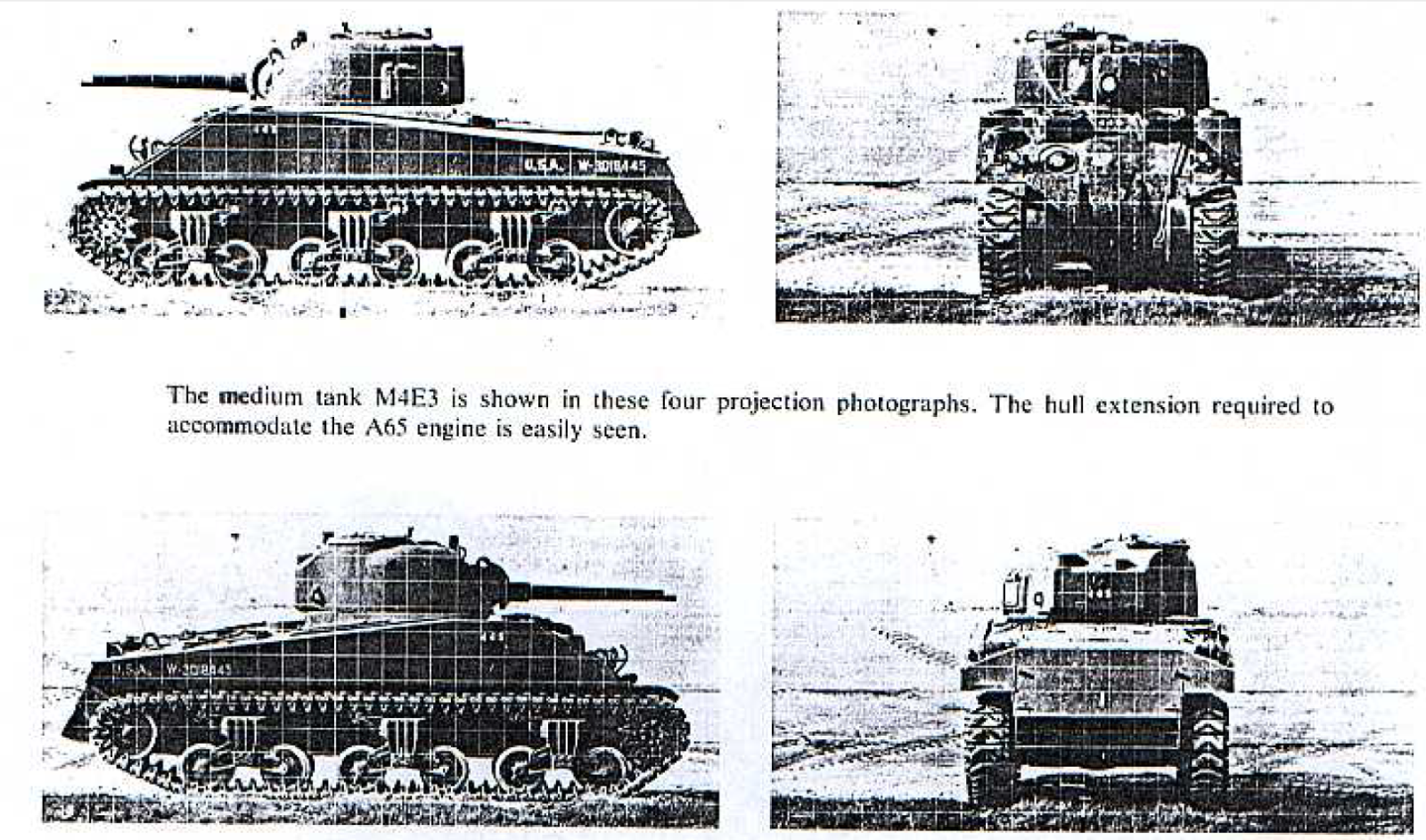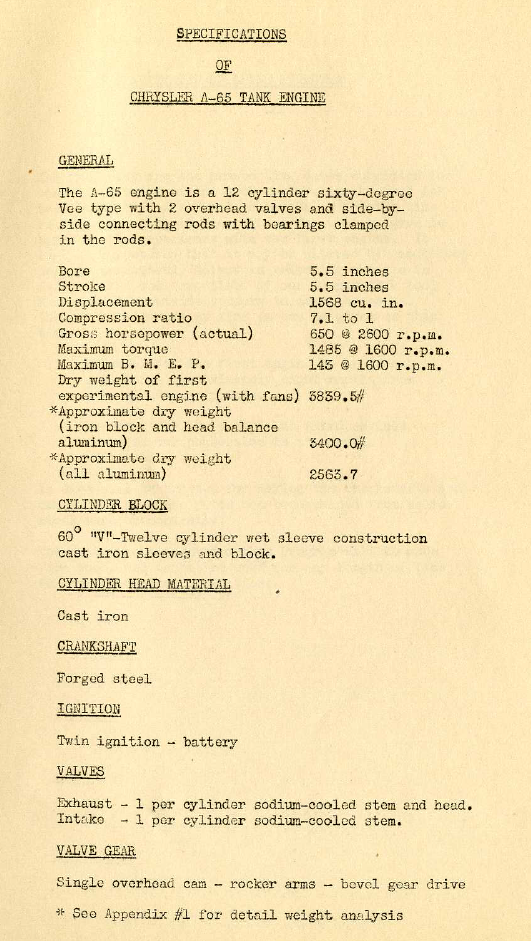The Chrysler Engine that could have been: The A-65 V12, if the war had gone on, there could have been some hotrod Shermans.
Chrysler Corporation had a big impact on the war, and US Tank production. They produced the first, and the model for the others, Tank Arsenal CDA. They also came up with the A-57 multibank tank motor, that powered a significant number of Sherman tanks. They produced this fantastically complicated, but also reliable motor in a very quickly, and even though the US Army and Marine Corps thumbed their noses at it, it was well liked by the British.
Chrysler on their own dime came up with a water cooled, V12, tank motor, and offered it to the Army. It took them about a year to come up with three trial motors. These 1568 cubic motors started out at 650 horsepower at 2600 RPM and 1485 pounds of torque at 1600 RPM on the test stand. They came in around 3840 pounds, but there was a proposed all aluminum version that have dropped nearly 1000 pounds. Designing and producing the prototypes, cost a grand total of 358,000 bucks, that’s over 5 million in today’s dollars. During the dyno testing period, they had a few problems with the fan drives, but these were solved with improved oiling and rolling bearings, and these seemed to have solved the problems.
They used an M4A4 as a test vehicle, and had to stretch it another 9 and 1/2 inches to fit the new motor. Installed and ready to roll the thing came in at 69,170 ponds, and a stock M4A4 came in at 69,640 pounds! Installed, the early versions had 549 horsepower, but they upped the compression ratio and got it to 580, and it was improved even more with some carburetion changes. They made the compression change by swapping and a cam change during the in vehicle testing phase. Further testing led to the intake and carb changes. All the while the motor was being swapped in and out, and driving tests done.
The automotive tests were very successful, and that was using the stock powertrain of the Sherman, though with so much power, they decided a gear change would help. By swapping the original 3:53:1 gears for 3:05:1 gears, they A65 was still able to beat an M4A43 in a drag race! The engine was so promising, it’s an interesting mystery why the Army never developed it further. Much like the GAA, there was much more performance potential in this motor, and the Army never took it any further.
I suspect what ultimately killed this motor, was the same thing that killed the GAA, the Army was looking at air cooled motors for the future, because you can save a lot of weight, if there is not liquid cooling system needed.
Special thanks goes out to Chris R, one of our readers and a source contributor, sent me a nice little history on the motor. Thanks again Chris, sorry it took so long!!
Sources: Sherman, by Hunnicutt, and 1943 A-65 Tank Engine History




Ok, according to the spec sheet, this engine had 7.1:1 compression ratio, 2 valves per cylinder, OHC. Fairly “high tech” for its day! My guess is that the CR had to be limited in order to run on what the Brits called (motor) “Pool” gasoline, which typically had a nominal 80 octane rating, but due to wartime exigencies could often be as low as 72 octane. No reference as to whether this prototype engine was a “Hemi” head, as Chrysler was working on a V-16 aircraft engine rated at 2,500 hp, considered the ancestor of the famous automotive “Hemi” engines.
if I recall right the US Army standard gas was either 80 or 85 octane, so engines like the A-57 had 6.2:1 and the 975 was 5.7:1 but I think that varied model to model on the R975. The GAA had a relatively high 7.5:1, but they probably got away with that because it was all aluminum.
You have to try really hard to break a slant six. I’ve owned two of them in Chrysler Corp. cars, and they were the most reliable engines I’ve ever seen–even more bulletproof than a small block Chevy with four bolt mains.
paper writing services write a paper online paper writing service [url=https://paperwritingservices.us.com]school papers[/url]
I know there was some discussion on using the Chrysler engine for the M26 and M29. However, there were plenty of the GAA engines available and by goosing that one to 550 horse, they felt the M26 still had better HP to weight ratio than a tiger, and that was enough.
I have a very vague reference to another Chrysler engine that reportedly was considered and/or experimented with in relation to the Sherman. In 1939, Chrysler debuted a new 331ci diesel of their own design (Lanova combustion system). Initially dubbed the T84 engine (later T106 and T126), it was (apparently) a concurrent development with a same displacement 331ci HD truck flathead gas engine (the T43, later T80). It debuted in Dodg 2 and 3-ton trucks starting in ’39 and was used in Dodge and Fargo 2-4 ton trucks into ’42. It also had marine and industrial applications and was sold that way into 1945, after which it was discontinued.
This information states the Chrysler diesels were used in a twin-bank setup like the Jimmy 6-71s. The reference, comes from the late author and Dodge authority Don Bunn in one of his many publications but without context or attribution. I am studying these diesel engines and trying to bunk or debunk the reference. I have my doubts about it for many reasons, mainly in that these diesels were of modest output (100 hp). That is half as much as the Jimmys (165 hp routine, 225 hp war emergency). A T84 powered Sherman would have been a slug indeed but stupider things were tested.
Relating to diesel, my initial run thru here doesn’t see anything on the larger of the two Guiberson radial diesels which were installed in a very limited number of Shermans.